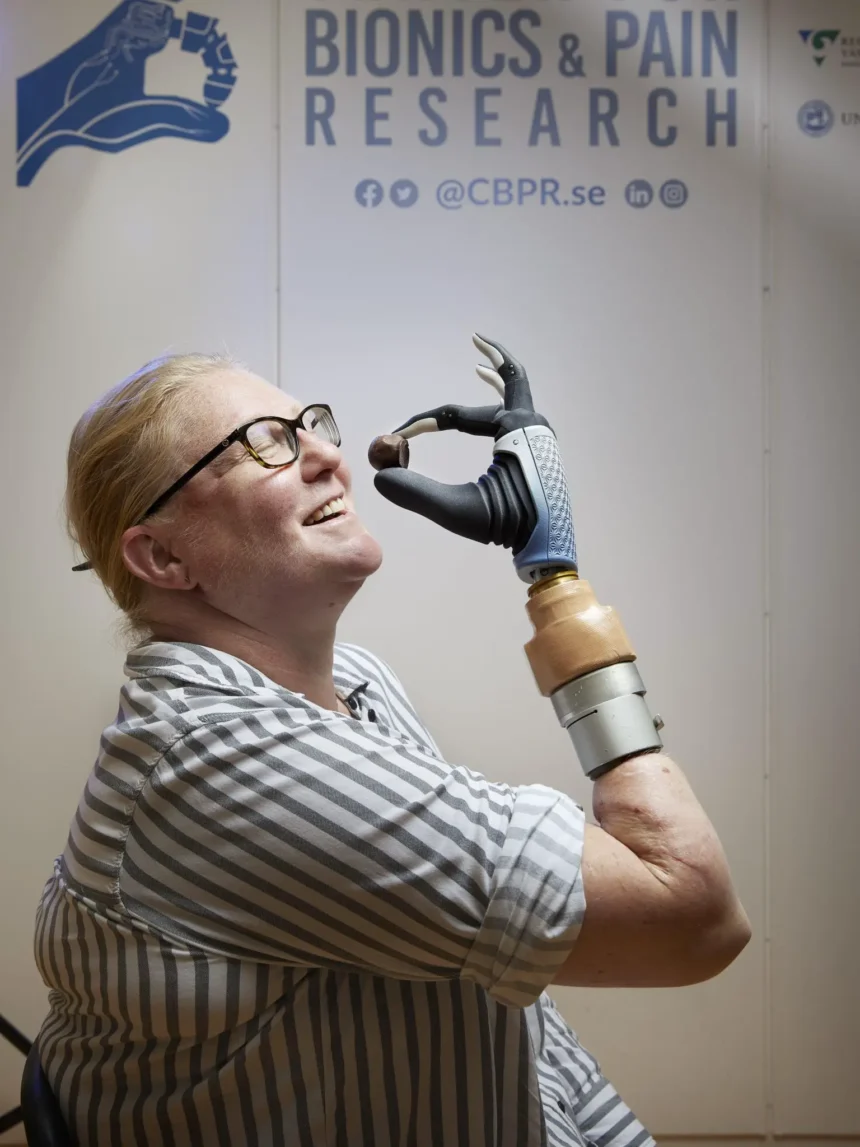A unique Bionic Hand was transplanted into a Swedish woman’s remaining bone, nerves, and muscles after she lost her right hand in a farming accident.
When Karin’s right arm was amputated over 20 years ago due to a farming accident, her life was drastically changed. Since then, she has had agonising pain in her phantom limb.
“It caused a great deal of stress and required me to take a lot of different medications since it felt like I had my hand in a meat grinder all the time.
She also discovered that conventional prostheses were painful and unreliable, which made them ineffective in daily life in addition to her chronic discomfort. All of this changed when she was fitted with a prosthesis that was far more functional thanks to cutting-edge bionic technology, which she was able to wear all day long. Karin’s pain was also reduced by the better level of integration between the bionic and her remaining limb.
A Remarkable Fusion of Human and Machine:Bionic Hand
Two of the main difficulties in artificial limb replacement are mechanical attachment and dependable control of prosthetic limbs. Because of these factors, people who have lost a limb frequently reject even the most advanced prostheses that are commercially available. This results in a painful and uncomfortable attachment with a meagre and uncertain degree of control.
These issues were resolved by a multidisciplinary team of engineers and surgeons who created a human-machine interface that permits the prosthesis to be securely fastened to the user’s skeleton via osseointegration and to be electrically connected to the nervous system via electrodes inserted in muscles and nerves.
The research was led by Prof. Max Ortiz Catalan, head of neural prosthetics research at the Bionics Institute in Australia and founder of the Center for Bionics and Pain Research (CBPR) in Sweden
Also read: Da Vinci’s Secret: Researchers Find Toxic Pigments In The Mona Lisa
Karin was the first patient with a below-elbow amputation to get this innovative design of a highly integrated bionic hand that can be relied upon and used freely in daily life. She has been using her prosthesis effectively and comfortably in daily activities for years, which is an encouraging sign for the potentially game-changing potential of this unique technology for people who are losing limbs.
The two bones (radius and ulna) that need to be positioned and loaded equally, as well as the limited area for implants and prosthetic components, provide complications at this level of amputation. However, the study team was able to create an appropriate neuromusculoskeletal implant that enables the user’s biological control system (the nerve system) to be connected with the electronic system.

A Bionic Hand
The decrease in discomfort is also explained by our combined surgical and technical approach because Karin is now using some of the same cerebral resources to manage the prosthesis as she did for her missing biological hand.
Another important objective for Prof. Ortiz Catalan’s team is the treatment and prevention of post-amputation pain. Karin stated that she now has “better control over my prosthesis, but most importantly, my pain has decreased” in relation to this issue. I take a lot less medication now.
The prosthesis’ skeletal relationship to the body via osseointegration, the process by which bone tissue embraces titanium to create a solid mechanical connection, is a vital component of the new bionic technology.
The surgery was performed by Prof. Rickard Brnemark, research affiliate at MIT, associate professor at Gothenburg University, and CEO of Integrum. He has worked with osseointegration for prosthetic limbs ever since they were first used in humans. We can restore human function in a completely new way using osseointegration, reconstructive surgery, implanted electrodes, and AI. The level of functioning attained represents a significant turning point for the field of advanced extremity reconstructions as a whole, despite the unique hurdles associated with below-elbow amputations.

A Bionic Hand
In order to give the prosthesis access to more sources of motor control information, the residual limb’s muscles and nerves were reorganised.
At the Sahlgrenska University Hospital in Sweden, where he also oversaw the first hand transplant in Scandinavia, Dr. Paolo Sassu performed this portion of the procedure. He said, “Depending on the clinical conditions, we can offer the best solution for our patients, sometimes being biological with a hand transplant, and sometimes being bionic with a neuromusculoskeletal prosthesis. We are always becoming better at both. Currently, Dr. Sassu works for the Centre for Bionics and Pain Research in Sweden and the Istituto Ortopedico Rizzoli in Italy.
According to coordinator Prof. Christian Cipriani from Scuola Sant’Anna in Pisa, the DeTOP project, funded by the European Commission, “offered a great opportunity for collaboration that made it possible to consolidate state-of-the-art robotic and prosthetic technologies available in our institutions, that may have a tremendous impact on people’s lives.”
The Mia Hand, a robotic hand created by Prensilia, had special motor and sensory features that let the user perform 80% of daily living tasks. According to Dr. Francesco Clemente, Managing Director of Prensilia, “the acceptance of the prosthesis is critical for its successful use.” Prensilia laboured to create a hand that could be completely customised cosmetically in addition to its technical performance. Mia Hand was created to be seen, not to be concealed. The users were supposed to be proud of what they are, rather than ashamed of what was lost
Reference: “A highly integrated bionic hand with neural control and feedback for use in daily life” by Max Ortiz-Catalan, Jan Zbinden, Jason Millenaar, Daniele D’Accolti, Marco Controzzi, Francesco Clemente, Leonardo Cappello, Eric J. Earley, Enzo Mastinu, Justyna Kolankowska, Maria Munoz-Novoa, Stewe Jönsson, Christian Cipriani, Paolo Sassu and Rickard Brånemark, 11 October 2023, Science Robotics.
DOI: 10.1126/scirobotics.adf7360
Also read: Bee Sex Is Determined By A Molecular Dice Roll, Solving A 100-Year-Old Genetic Mysteries




































